Do pesky flies and insects always seem to find their way into your home, no matter how often you shoo them away? If so, investing in retractable window fly screens is a wise move.
These screens allow you to enjoy fresh air and natural light without the annoyance of bugs buzzing around. But, to ensure the longevity and effectiveness of your fly screens, it is important to maintain them properly.
In this article, you will dig into five essential tips to help you keep your retractable window fly screens in excellent condition.
1. Remove Dust, Debris, and Insect Remains
To maintain your retractable window fly screens, regularly remove dust, debris, and insect remains. Use a soft brush or vacuum cleaner to gently sweep away accumulated particles.
For stubborn dirt, a mild, soapy solution and a soft cloth can be employed. Keeping the screens clean ensures they function optimally and allows for clear visibility. Additionally, it prevents the buildup of allergens and maintains a hygienic environment.
2. Check for Tears, Holes, or Loose Components
Regularly inspect your retractable window fly screens for tears, holes, or loose components. To do that, gently run your fingers along the screen, examining for any damage or signs of wear.
If you notice any small tears or holes, prompt repairs can prevent them from worsening. Ensure the screen is securely fitted in its frame, with no loose or damaged components. Addressing these issues promptly maintains the effectiveness of the screens in keeping insects out.
3. Apply Silicone or Graphite Lubricant
Keep your retractable window fly screens gliding smoothly by applying silicone or graphite lubricant. To cut down on friction, put a little on the tracks and moving parts. This simple step ensures the screens retract and extend effortlessly, preserving their functionality.
However, avoid using oil-based lubricants, as they can attract dust and debris. Applying the right lubricant every few months helps maintain the ease of operation for your retractable window fly screens, contributing to their longevity and ensuring they function seamlessly when needed.
4. Adjust Tension Springs
Maintain the proper tension in your retractable window fly screens by periodically adjusting the tension springs. These springs play a crucial role in the smooth operation of the screens. To get the tension you want, use the screws on the sides of the screen housing to make changes.
Ensuring the correct tension prevents the screens from sagging or becoming too tight. If you make adjustments to your retractable window fly screens on a regular basis, maybe every six months, they will last longer and work better, protecting your windows from bugs.
5. Secure Storage During Off-Season
During the off-season or when not in use, secure the retractable window fly screens by properly storing them. Clean the screens, as mentioned earlier, then retract them fully into their housing. Ensure they are dry before storage to prevent mold or mildew.
If possible, cover them with a protective case or store them in a cool, dry place. Proper storage not only safeguards the screens from potential damage but also ensures they are ready for use when the insect season returns.
Ensure Longevity and Optimal Performance, Protect It Now
With these measures in place, you not only protect your investment but also guarantee that your retractable window fly screens continue to serve their purpose effectively. So, ensure your screens’ longevity and optimal performance—protect them now for uninterrupted comfort and peace of mind.


